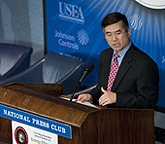
U.S. Secretary of Commerce Gary Locke keynoted the 21st Annual Energy Efficiency Forum in Washington, D.C. (Photo credit: Herman Farrer Photography)
Locke stated that energy efficiency must be deployed along with new, clean sources of energy. “The U.S. currently consumes more than 20 percent of the world’s oil, yet we only have 2 percent of the world’s reserves,” he said.
Because of this, U.S. businesses must be ready to lead in clean energy development. This “could spur one of the greatest economic opportunities of the 21st century,” said Locke.
“Efficiency is the low hanging fruit,” he said. It is the least expensive and easily scalable option. It’s merely maximizing our current sources of energy.
“Investments in emerging technologies like solar, wind, and advanced batteries are vital to this nation’s future,” Locke said. Over the medium to long-term, they offer great potential. But some clean energy solutions are not yet ready for mass commercialization. “Efficiency is ready right now.”
Describing programs at the Commerce Department, Locke said that the U.S. Patent and Trademark Office has a fast-track program for energy-related patent applications to get them processed in less than 12 months. He also noted that the National Institute of Standards and Technology (NIST) “has been asked by Congress to coordinate and accelerate the development of interoperability standards for the smart grid.” A nationwide smart grid could “help reduce power demand by more than 20 percent,” he said. And a smart grid would help deal with the multiple sources of energy coming into the grid.
China is working to become the world leader in clean energy, said Locke. The U.S. can’t afford not to pursue clean energy development. “We have to act.”
Locke asserted, “When you get the incentives right, the private sector can respond with solutions that are both more effective and more affordable than anyone would have imagined.” This can be applied, he said, to the development of clean energy and the deployment of energy efficiency technologies.
Publication date:06/28/2010




